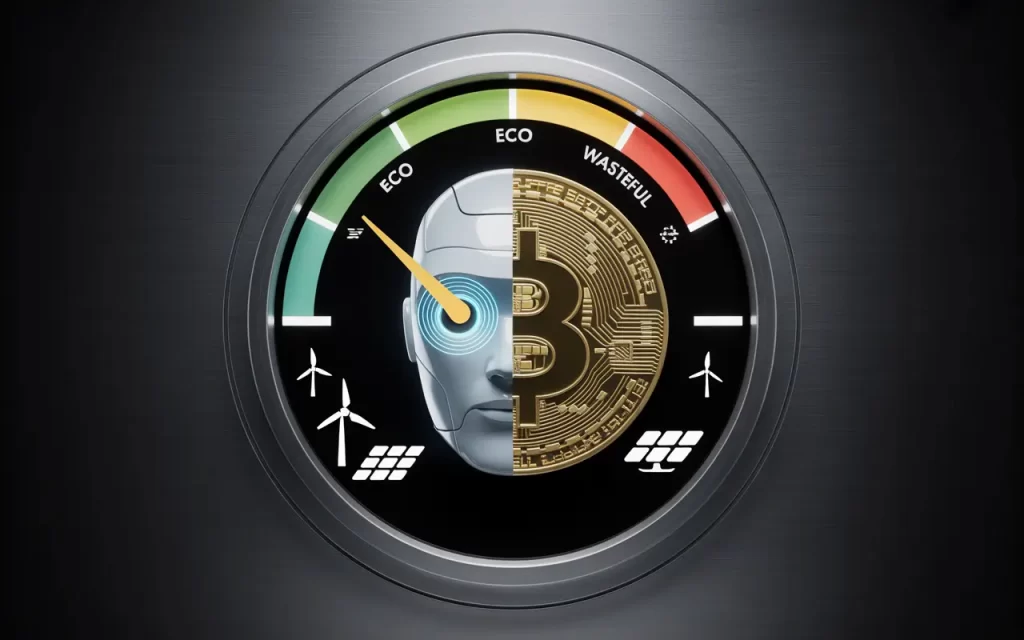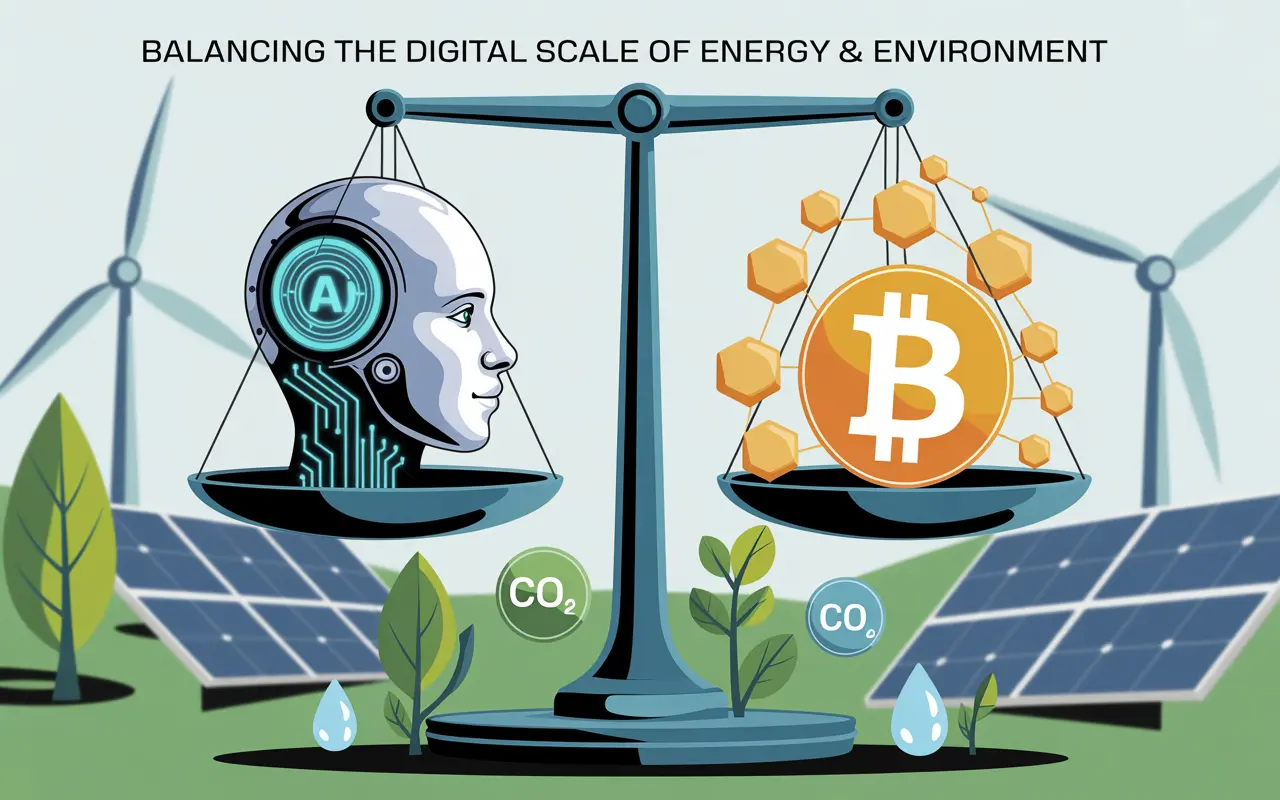Sustainable energy use has always been a big concern for me and the InfluxJuice team. With AI and Bitcoin’s usage increasing all the time, what impact is that having on the environment?
AI language models and Bitcoin have very different environmental footprints, but the picture is more nuanced than many headlines suggest. While a single AI chatbot reply uses a fraction of the energy and water of a Bitcoin transaction, training AI models can involve huge one‑time carbon and water costs, and both industries’ impacts vary greatly depending on how clean their energy sources are.
Understanding the numbers in context may help you and your business, as well as decision‑makers, tech leaders, and policymakers make sustainable choices.
👀 Quick answers — Jump to section
- Environmental Impact: Key Numbers on Sustainable Energy
- What’s Driving These Differences?
- AI vs Bitcoin: Pros and Cons for the Environment
- Why Geography Changes the Story
- Scaling: One-off vs Continuous Costs
- Understanding the Utility Context
- Actionable Sustainable Energy Steps
- InfluxJuice’s Role in Sustainable Energy
- Why Partnering with Sustainable Energy Agencies Matters
- AI, Bitcoin, Sustainable Energy, and the Path to a Cleaner Digital Economy
- Pulling the Numbers Together — Context over Clickbait
- The Takeaway for Decision‑Makers
- FAQ
- Final Thoughts on Sustainable Energy
1. Environmental Impact: Key Numbers on Sustainable Energy
| Metric | Mistral Large 2 (AI) | Bitcoin Transaction | Bitcoin Network (2024) |
|---|---|---|---|
| CO₂ Emissions | 20.4kt for training/ops | 600–700kg per transaction | ~48Mt total |
| Water Consumed | 281,000m³ total | >17,000L per transaction | >2 billion L total |
| Minerals/E‑waste | 660kg antimony-eq | 130g e‑waste per tx | >20,000t e‑waste total |
(Sources: Mistral AI, Cambridge Centre for Alternative Finance)
Why this matters:
These figures show that AI’s per‑use footprint can be tiny compared to Bitcoin, but AI’s training cycles carry high one‑time costs. Bitcoin’s design locks in ongoing, repeated energy use no matter how many transactions occur.
2. What’s Driving These Differences?
- AI Models (e.g., Mistral Large 2)
- Most emissions come during training, which can take millions of GPU‑hours.
- After training, each interaction (“inference”) adds minimal carbon, water, and material usage.
- The cleaner the local power grid, the smaller the impact.
- Bitcoin Proof‑of‑Work
- Mining is always on, solving complex puzzles every 10 minutes.
- Every transaction shares part of that fixed energy cost.
- Mining rigs constantly upgrade, creating e‑waste.
- Key Variable: Energy Source
- Bitcoin: Hydropower, wind, and solar now make up more than 40% of mining power. Nuclear adds another ~8%, but coal and gas remain significant (~44%).
- AI: Often benefits from concentrating operations in cleaner‑energy regions (e.g., EU’s 22% nuclear share).
3. AI vs Bitcoin: Pros and Cons for the Environment
| Factor | AI Models | Bitcoin |
|---|---|---|
| Energy-to-task ratio | Low after training | High and ongoing |
| Water consumption | High in training, low daily | Very high for cooling rigs |
| E‑waste/materials | Moderate (GPU/data center) | Significant due to rig churn |
| Renewable energy share | Grid‑dependent (some high) | Growing but uneven globally |
| Scaling effect | Cheap per extra use | Linear – cost stays constant |
Takeaway:
Bitcoin’s environmental load grows steadily over time, while AI has spikes during training but low marginal costs for daily interactions.
4. Why Geography Changes the Story
AI example:
A model trained in a French data center (with nuclear-heavy energy mix) will produce fewer CO₂ emissions than one trained in a U.S. coal-heavy state.
Bitcoin example:
Mining operations in Quebec (hydro-rich region) are far less carbon-intensive than those in Kazakhstan, where coal dominates.
Lesson:
For both industries, relocating to cleaner grid regions can drastically reduce environmental harm without changing the technology itself.
5. Scaling: One-off vs Continuous Costs
- AI:
- The cost to train a model like GPT‑4 could involve tens of millions of GPU hours.
- Once trained, that cost is “amortized” over millions of uses, making per‑interaction impact tiny.
- Bitcoin:
- Energy use is continuous, tied to time, not usage.
- Even if transactions drop, miners keep working to secure the network and earn rewards.
- The halving event every four years reduces block rewards, nudging miners toward efficiency.
6. Understanding the Utility Context

It’s not only about the numbers. Each technology’s purpose matters:
- Bitcoin secures a decentralized, borderless, censorship-resistant financial network.
- AI Models enable rapid information access, decision-support tools, automation, and creative generation.
Both will be major pillars of the global digital economy, and their environmental profiles deserve equal scrutiny.
7. Actionable Sustainable Energy Steps
- Choose green energy hosting or mining – Hydro, wind, nuclear where possible.
- Increase transparency – Follow Mistral’s lead and publish audited environmental metrics.
- Upgrade hardware efficiency – Longer lifecycles to reduce e‑waste.
- Locate strategically – Base operations in areas with the cleanest grids.
- Offset while reducing – Tree planting, eco‑certificates, or other verifiable offsets.
8. InfluxJuice’s Role in Sustainable Energy
At InfluxJuice, we believe marketing can be a force for good. That’s why we’ve partnered with Evertreen, planting 50 trees for every marketing campaign we run. This action offsets carbon emissions while restoring ecosystems and supporting local communities.
When you work with us:
- You grow your brand through high‑impact, data‑driven marketing.
- You build your brand’s authority and reputation through our site and marketing optimisation.
- You get found by Search Engines (Google, Ecosia, Bing) and ranked on the first page.
- You get found by Generative Engines (ChatGPT, DeepSeek, Claude) and referenced by them.
- You contribute to global reforestation with each campaign launch.
- You help reduce environmental damage by offsetting part of your digital footprint.
- You support local jobs and biodiversity, as our reforestation projects employ farmers and protect endangered habitats.
It means every campaign doesn’t just deliver ROI, it leaves an environmental legacy.
9. Why Partnering with Sustainable Energy Agencies Matters

Choosing suppliers and partners who prioritise sustainability isn’t a “nice to have” anymore. It’s part of long‑term business resilience. Just as the public is scrutinising the impact of AI and Bitcoin, more customers now expect brands to prove they are doing their part.
By choosing sustainable marketing partners, you:
- Align your brand with eco‑conscious values customers care about.
- Proactively reduce your scope 3 emissions (indirect emissions from suppliers).
- Differentiate your business in a competitive digital economy.
Brands that show tangible action, like funding tree planting, using renewable energy suppliers, or reducing e‑waste, earn more trust and loyalty.
10. AI, Bitcoin, Sustainable Energy, and the Path to a Cleaner Digital Economy
Here’s how both industries can move toward a greener future:
For AI providers:
- Prioritise training in regions with clean grids.
- Invest in water‑efficient cooling solutions.
- Share footprint data openly so customers can make informed choices.
For Bitcoin miners:
- Shift operations toward renewable‑rich regions like Quebec, Norway, or certain parts of Texas.
- Extend mining rig lifespans and implement recycling programmes.
- Adopt immersion cooling systems to cut water usage.
These changes reduce environmental harm while keeping the core purpose and utility of these systems intact.
11. Pulling the Numbers Together — Context over Clickbait
A surface‑level comparison shows a single Bitcoin transaction consumes thousands of times more energy and water than an AI chatbot reply. That’s true, but telling only half the story risks misleading decision‑makers.
When you account for:
- AI’s huge one‑time training costs vs Bitcoin’s continuous energy draw.
- The regional energy mix where each operates.
- The utility provided by each network.
…the environmental debate becomes more balanced, data‑driven, and productive.
12. The Takeaway for Decision‑Makers
If your business works with AI tools or interacts with blockchain networks like Bitcoin, you don’t have to accept their environmental cost as “fixed.” You can:
- Ask tough questions about suppliers’ energy sources.
- Select alternative service providers based in clean‑energy regions.
- Manage usage patterns to lower unnecessary load on systems.
- Offset what you can’t reduce through credible, verifiable programmes.
These are the same principles we apply at InfluxJuice for our own operations.
13. FAQ
Q: Which uses more energy, AI or Bitcoin?
A: On a per-use basis, Bitcoin transactions consume far more energy than AI queries. However, training large AI models requires massive one-off energy and water costs.
Q: Why does Bitcoin use so much electricity?
A: Bitcoin relies on proof-of-work mining, which runs continuously to secure the network. This design means energy is consumed 24/7, regardless of transaction volume.
Q: How does AI impact the environment compared to Bitcoin?
A: AI has spikes in environmental cost during model training, but after that, each interaction has a much smaller footprint. Bitcoin’s energy use is constant and ongoing.
Q: Does dark mode or efficient coding make AI greener?
A: Small UX tweaks save device-level energy, but the real impact comes from training models in regions with clean energy grids and improving hardware efficiency.
Q: Can Bitcoin become sustainable?
A: Yes—by shifting mining operations to renewable-rich regions like Quebec, Norway, or Texas, and by upgrading to more efficient hardware and cooling systems.
Q: Can AI be trained sustainably?
A: Yes—by training in regions with clean energy, investing in water-efficient cooling, extending hardware lifecycles, and publishing transparent environmental reports.
Q: Which is worse for climate change: AI or Bitcoin?
A: Neither is inherently worse—it depends on energy source, scale, and how systems are managed. Bitcoin has continuous costs, while AI has large but one-off training costs.
Q: How can businesses reduce their digital energy footprint?
A: Host services on renewable-powered data centers, choose suppliers who disclose sustainability metrics, extend hardware lifecycles, and offset emissions responsibly.
14. Final Thoughts on Sustainable Energy
Both AI and Bitcoin are here to stay, each is shaping the digital economy in its own way. But with innovation comes responsibility. The environmental footprint of these technologies is driven by the choices we make now about energy, transparency, and efficiency.
As the numbers show:
- AI can be highly efficient at scale but costly to train.
- Bitcoin has a consistent operational energy cost but is improving its renewable share.
Neither system is inherently “good” or “bad” for the planet. It’s how we run them and where we source our power that makes the difference.
At InfluxJuice, we help brands grow while contributing to a healthier planet. Every campaign we run plants trees, restores ecosystems, and proves that marketing can be part of the solution, not the problem.
Bottom line: If you want your growth strategy to work for both your business and the environment, start by partnering with agencies that walk the talk. With the right choices, we can build a thriving digital economy and a greener world.
_________________________________________________________________
Get your business referenced on ChatGPT with our free 3-Step Marketing Playbook.
Want to know how we can guarantee a mighty boost to your traffic, rank, reputation and authority in you niche?
Tap here to chat to me and I’ll show you how we make it happen.
If you’ve enjoyed reading today’s blog, please share our blog link below.
Do you have a blog on business and marketing that you’d like to share on influxjuice.com/blog? Contact me at rob@influxjuice.com.

